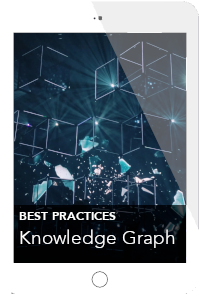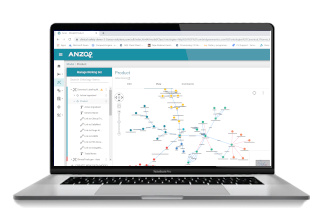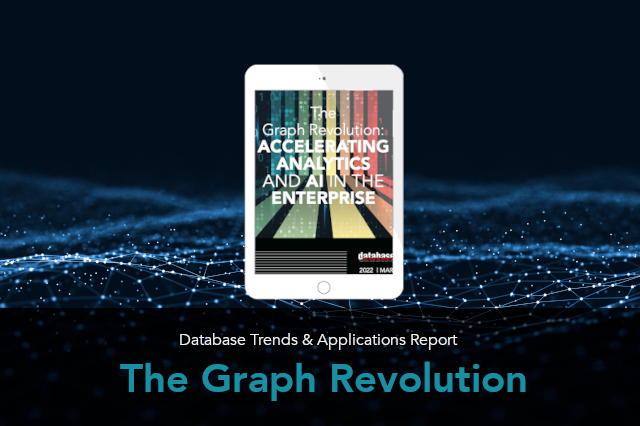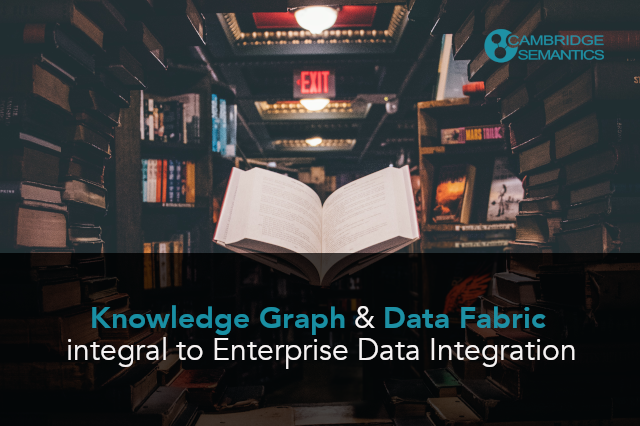
Knowledge Graph
These are the knowledge graph best practices; we cover everything from consideration, to evaluation, to implementation, and to expansion of a knowledge graph environment. If you want to build a successful phase one knowledge graph, on time, on budget, with real ROI... this is a great place to start.
Why Knowledge Graph
Today's hottest data management and data architecture trends revolve around the idea of leveraging metadata to assign meaning to data in disparate silos/sources that a centralized processing engine can then identify, contextualize and consume. From the users' perspective, this is done without care or worry as to where the underlying data lives; however, the system retains this information for various purposes.
There are many conceptual data architecture terms that fall into the realm, but in favor with practitioners and analysts is the data fabric architecture.
Gartner defines data fabric as a design concept that serves as an integrated layer (fabric) of data and connecting processes. A data fabric utilizes continuous analytics over existing, discoverable and inferred metadata assets to support the design, deployment and utilization of integrated and reusable data across all environments, including hybrid and multi-cloud platforms.
Enter Knowledge Graph
The Data Fabric is a contemporary concept to provide frictionless access to information, to improve decision making, and to adapt in a volatile world. Consequently, knowledge graph technology has been thrust into the spotlight. Data fabrics powered by knowledge graph technology provide new approaches to data management, integration and access. Further, careful examination and experience show that knowledge graphs built on W3C Semantic Web standards are the logical choice for implementation.
Concepts such as data centricity, data as a product, and responsibility to share represent fundamental changes in how enterprises operate. The ebook title “The Rise of the Knowledge Graph” discusses these concepts in detail and provides an excellent resource for getting started.
Customers who engage us understand these concepts, or they sense there is something new and important that they need to understand. To promote adoption of knowledge graph technology-based approaches, these best practices will help a person go from considering the project, evaluating various vendor's solutions, and to actually moving forward.
These best practices provide advice on how to market a knowledge graph initiative internally, and how to plan and run the project optimally to produce the ideal outcome — a phase one knowledge graph, on time and on budget with real ROI.
Building Knowledge Graph Momentum
Educating Others About Knowledge Graph and Getting Support for the Project
As a software company with decades of experience in knowledge graph technology and applications, we are sharing our knowledge and experience with others because we understand the need is great and will affect positive outcomes for data management and decision making.
Just as we are creating awareness and educating readers about knowledge graph technology, a person seeking to promote adoption in their organization should do likewise. But a prerequisite is to understand the concepts yourself. A great resource for this is, again, the ebook. After you arm yourself with a good grasp of the concepts, their capabilities and how knowledge graph changes the data management paradigm, you are in a better position to educate and inform others.
When you develop your message, perhaps start by focusing on why knowledge graph technology is important. There is a dynamic in virtually every data rich organization that features a use case driven approach to data collection and preparation and consumption. If you understand knowledge graph technology, you know the movement seeks to shift from an application-centric (i.e., use case-driven) approach to treating data as a product (i.e., data centricity).
In the application-centric approach so dominant today, we apply (too much) human capital to transactional workflows. Meaning users, and certainly developers, spend a lot of time wrangling data to “fit” applications. This is a waste. If you communicate to users, solution architects and developers how life will be different using the knowledge graph approach, they should want it. For example, executives want to “know what they know,” and they want it from a single “pane of glass.” Moreover, leaders want to know, “what’s next”? Knowledge graph technology is the critical enabler.
Since the knowledge graph integrates potentially all your data sources, you now have a way to deliver information in one “place.” You also have a way to allow users to pivot around all content and ask ad hoc questions. Perhaps subtle, you also can deliver information that is based on the concepts they care about (i.e., how users think), as opposed to delivering data based on schemas and data types.
If Digital Transformation is a key objective of your organization, knowledge graph will play a vital role. While we commonly discuss consumption of knowledge graphs from a human perspective, this technology is ultimately intended to serve automated clients and processes. Specifically, W3C RDF and W3C OWL are envisioned to create a means to enable sophisticated machine-to-machine interactions; and that is where this is going.
After you develop your message for “why knowledge graph,” you want to explain clearly and accurately what knowledge graph technology is. Arguably, a knowledge graph consists of “knowledge” and “graph.” The graph part is RDF, and it represents the way to structure and convey data. The knowledge part is OWL, and it provides the mechanism to represent meaning; that is, what things are and how the things relate to each other.
The combination results in schema-less and self-describing data that is easily consumable and understandable by humans and machines. After all, we are largely in the current predicament because we didn’t factor such ideas into our early database systems or our file formats. We didn’t necessarily consider that others would want to use “our” data or that our data was related to others’ data. The knowledge graph explicitly assumes that data from different sources is related and that others may want to consume it.
Selecting Your First Knowledge Graph Use Case
Seeing is believing and nothing breeds success like success. So the next thing you should do is develop a demonstration. The demonstration should concretely illustrate what a knowledge graph is, and how it helps users and decision makers.
Nobody cares more about their own problems than themselves, so the data you use should be relevant to your audience. As a vendor, we have developed many demonstrations! But none are more effective than those that illustrate the capabilities using the audiences’ data. For example, we developed a Maritime Common Operating Picture (COP) demo using real world data from a geopolitically important region. We felt the power of this demo was that many audiences understand the domain, the need, and the data.
This next idea may seem contradictory, but it’s necessary. Identify a use case you know will resonate with your audience. Then use data from sources that support that use case. But consider ways the knowledge graph developed from these sources can be reused across other applications. Knowing what you know about “data centricity,” construct your knowledge graph in the context of a product. Represent to the audience the concepts and relationships, not the physical aspects. At a minimum, the concept-oriented view will show that you are doing something different. In other words, a user doesn’t necessarily care about “how” the data is delivered to them, but they will care about how it is represented (i.e., modeled) to them.
We have found knowledge graph technology is an easier sale to technical audiences, especially visionaries and architects. They more readily grasp the differences and can see the benefits. Nevertheless, data searching and preparation are so ingrained in the collective mindset that technical people often conclude that it’s just not necessary. But when they realize how it makes their lives easier, they lean forward to pay attention.
As an anecdote, we once worked on a project wherein the customer tasked us to survey the users of an existing system and ask them what they would like in the new system. We asked an analyst, “what if the system automatically connected and presented data from many sources for you?” The answer, which was revealing, was, “That’s my job!” At that moment, I realized we had a serious challenge.
So, what did we do? We created a knowledge graph from several sources, configured a dashboard with different views that surfaced data from many sources in a single pane of glass. Mind you, it was not a simple aggregation, or roll up, of multi-source data. It was a fully integrated and articulated knowledge graph. We showed the audience how they could configure different views based on their use cases or questions. From that point, they were hooked!
What it meant for them was that they no longer had to fetch data from many sources and then create complex spreadsheets of aggregated data, which was time consuming and error prone. They could simply point and click to filter data based on their questions. This was a game changer.
Your demo needs to show these capabilities and it needs to show them using operationally relevant data.
Some readers may already be putting up mental barriers — objections — in their minds. We address common barriers in this blog post.
Required Knowledge Graph Roles & Skills
If new skills and roles are required to adopt knowledge graph technology, the barrier to adoption might be too great. A good implementation abstracts the technical details, but still allows those savvy in graph operations to interact with the “raw” knowledge graph.
With effective abstraction, tooling, workflows and APIs, your knowledge graph solution is accessible, manageable and sustainable by contemporary users and developers. There is no need for new roles or skills.
 When you assemble your team, focus on existing personnel and how they can support the knowledge graph paradigm. Depending on your implementation, roles such as Database Administrators will find that life is easier. Users and developers are more empowered, which reduces the burden on traditional Database Administrators.
When you assemble your team, focus on existing personnel and how they can support the knowledge graph paradigm. Depending on your implementation, roles such as Database Administrators will find that life is easier. Users and developers are more empowered, which reduces the burden on traditional Database Administrators.
Knowledge graphs built on RDF and OWL are resource-oriented, which means they lend themselves well to RESTful services architecture. In fact, the implementation should, or at least could, be a self-similar design, which means the software system that manages the knowledge graph is also built on RDF and OWL. This promotes high cohesion and consistency.
Trust and Confidence in Knowledge Graph Data
A new function arises from semantically integrated data: verification and validation. When multi-source data is used to create a knowledge graph, users and automated clients access information that is combined from potentially many sources. A decision maker cannot or will not simply act on this information unless he or she has confidence. And that confidence is enabled through verification and validation. In other words, your implementation needs to provide provenance for every field or property of data.
If you think about it, we can employ the current roles and skills to create and manage knowledge graphs; however, we are “inverting” the data access model from a “bottom up” process to a “top down” process. Yes, it’s true that we construct the knowledge graph from data sources, but that’s a necessity born from legacy approaches to data management. In the future, data will align directly to knowledge models and will inform decision makers and other consumers from an information view. The “data view” will support findings and conclusions. And don’t forget! The knowledge graph paradigm is ultimately for increasingly autonomous systems, which implies that humans have an important role in verification and validation. The “garbage in, garbage out” principle still applies.
Knowledge Graph Preparation
Ironically, the biggest challenge you might face to getting a knowledge graph project underway is getting access to the source data! This is more common than one might think, and it reveals an interesting truth. People know intuitively that data is valuable, and its value creates interesting dynamics. This is partly why we say culture can be more important than technology. So when preparing your project, ensure that you have access to the data sources you need.
To implement, demonstrate and manage your knowledge graph, you need appropriate software. While it is true that one can encode a knowledge graph using a text editor, that would be tantamount to boiling the ocean. A number of commercial and open source software solutions are available. Open source software tends to be more developer-oriented, and commercial software tends to be more abstracted, scalable and maintainable. You basically are going to pay people to develop your knowledge graph solution, or pay a license to those who have already developed a solution platform. We're biased, but we recommend the latter.
Why? Knowledge graph is something of a paradigm shift for data. As such, your risk is considerably higher than continuing the status quo. Engaging with a commercial company provides you access to grizzled veterans who understand deeply the tactics, techniques and best practices. They share a mutual interest in your success. The use of a commercial solution platform will allow you to focus on rapid time to value and business outcomes.
Know what you want to show end users and stakeholders
Our experience is that technical audiences appreciate the strategic value more than users or executives. So they can be an ally or an obstacle. From experience, it seems like end users and decision makers should be the primary targets.
 Think about the user interfaces you plan to show. Displaying dense graphs of nodes and edges — fuzzballs — is not going to win the audience. A simple tabular display of semantically integrated data from multiple sources can be more effective. From various columns in the table, provide links that drill into related information. This simple approach can be powerful for people who spend a lot of time querying multiple systems, aggregating data from those systems, and then organizing the data for use. It quite literally displays multi-source data in one view.
Think about the user interfaces you plan to show. Displaying dense graphs of nodes and edges — fuzzballs — is not going to win the audience. A simple tabular display of semantically integrated data from multiple sources can be more effective. From various columns in the table, provide links that drill into related information. This simple approach can be powerful for people who spend a lot of time querying multiple systems, aggregating data from those systems, and then organizing the data for use. It quite literally displays multi-source data in one view.
Also prepare traditional charts and graphs. Bar charts, line charts, bubble diagrams, heat maps, etc are familiar and relatively easy to understand. Your challenge is to show how easy it is to feed those views from multiple sources. Remember, knowledge graphs are about processing data and they enable more effective and efficient analysis.
Another aspect of your demo should highlight relational navigation. You might call these filters. Your demo should provide multiple views along with user-configurable filters that allow them to rapidly select and narrow down displayed information. These are essentially highly parameterized questions.
To be sure, users and developers will say things like, “We already have filters.” True, but a good knowledge graph application will dynamically create filters from the knowledge graph. In other words, the filters come from the data, not prebuilt application-specific rules. This creates a new capability for users (and automated clients) to easily ask unanticipated questions! This capability further empowers end users to be more self-sufficient.
Think about things like hypothesis testing or discovery. Knowledge graphs allow users to ask questions of the entire knowledge graph and in arbitrary combinations. This is new.
What are common reasons for project delays in your organization?
Popular next steps are circulating the O’Reilly Knowledge Graph Ebook and demoing our knowledge graph platform Anzo.
If you’d like to speak to one of our knowledge graph experts, simply fill out the form on this Anzo demo web page and we will do our very best to hold your hand through your knowledge graph journey.


